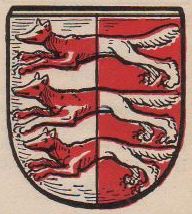Kochstedt: Difference between revisions
Jump to navigation
Jump to search
Knorrepoes (talk | contribs) |
Knorrepoes (talk | contribs) m (Text replace - "[[Literature" to "{{media}} [[Literature") |
||
| Line 16: | Line 16: | ||
====Origin/meaning==== | ====Origin/meaning==== | ||
The arms are based on the divided arms of [[Halberstadt]], as the village was a possession of the Bishop of Halberstadt. The meaning of the three foxes is not clear. The arms were most likely granted in 1535, as the oldest seal of the city shows that date. In 1535 the city of [[Gröningen]] received arms in a very similar design from Cardinal Albrecht von Brandenburg, Bishop of Halberstadt. | The arms are based on the divided arms of [[Halberstadt]], as the village was a possession of the Bishop of Halberstadt. The meaning of the three foxes is not clear. The arms were most likely granted in 1535, as the oldest seal of the city shows that date. In 1535 the city of [[Gröningen]] received arms in a very similar design from Cardinal Albrecht von Brandenburg, Bishop of Halberstadt. | ||
{{media}} | |||
[[Literature]] : Image from Kaffee Hag Albums | [[Literature]] : Image from Kaffee Hag Albums | ||
Revision as of 23:58, 8 July 2014
| Heraldry of the World Civic heraldry of Germany - Deutsche Wappen (Gemeindewappen/Kreiswappen) |
KOCHSTEDT
State : Sachsen-Anhalt
Urban District (Kreisfreie Stadt) : Dessau-Roßlau
Incorporated into: 1950 Dessau (2007 Dessau-Roßlau)
Origin/meaning
The arms are based on the divided arms of Halberstadt, as the village was a possession of the Bishop of Halberstadt. The meaning of the three foxes is not clear. The arms were most likely granted in 1535, as the oldest seal of the city shows that date. In 1535 the city of Gröningen received arms in a very similar design from Cardinal Albrecht von Brandenburg, Bishop of Halberstadt.
Contact and Support
Partners:
Your logo here ?
Contact us
© since 1995, Heraldry of the World, Ralf Hartemink 
Index of the site
Literature : Image from Kaffee Hag Albums











